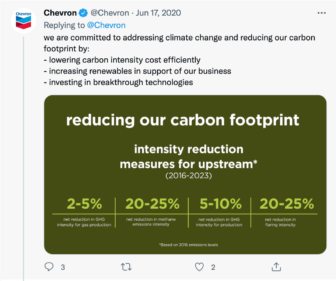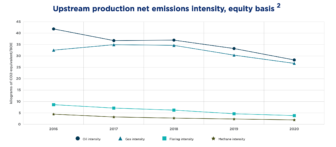For decades oil and gas companies have deliberately misled the public on the risks from extraction and fossil fuel use. Today, many claim to be turning a new page with climate pledges, commitments, and rhetoric that sound great on the surface.
Don’t be fooled, behind their word play is dangerous climate delay.
Evidence recently provided by Chevron via this online tool suggests that they (and possibly others for that matter) are falsely using confusing language to suggest to investors and consumers that they are reducing their carbon footprint. The truth, according to Chevron’s own data is clear: their carbon footprint is growing.
The Intensity Metric Myth:
If you take a look at almost any oil and gas company’s climate commitments you will see commitments to reduce “emissions intensity.” Chevron’s climate plan relies on intensity metrics.
When a company like Chevron uses the phrase “emissions intensity,” they’re talking about a mathematical formula of emissions released per unit of their product captured for sale (for oil the unit is a barrel and for gas the unit is barrel of oil equivalent or BOE). What this intensity metric does not measure is total pollution, which is what matters when we’re talking about a warming climate. We first challenged this misinformation campaign in 2019 when industry trade groups began using methane intensity metrics to distort the truth about the pervasive problem with methane pollution from oil and gas operations.
In March of 2021 we sent a complaint with Global Witness, and Greenpeace USA to the Federal Trade Commission which laid out (among other things) how Chevron was using the word intensity to possibly mislead consumers in this marketing campaign claiming they were reducing their carbon footprint by reducing their carbon emissions intensity:
To use the word “intensity” in their climate metrics without explaining what it means is misleading. But companies that use it to suggest they are reducing their carbon emissions overall could be lying to investors and consumers and should be a major concern to any agency overseeing corporate behavior.
Debunking the Myth:
Recently Chevron published data that verifies what our complaint to the FTC suggested: reducing emissions intensity does not mean reducing emissions.
According to their own data, from 2016 to 2020 Chevron reduced its methane intensity by 56%, flaring intensity by 55%, oil Intensity by 32%, and gas intensity by 18%.
At the same time Chevron increased overall emissions (carbon footprint) by nearly 40 million metric tons or 6%. Between 2016 and 2019 they increased by nearly 80 million metric tons before production slowed down due to the pandemic.
Not only is Chevron’s ad stating “reducing our carbon footprint” while only planning to reduce emissions intensity misleading, it’s just not true.
Climate Delay:
What good are climate plans that allow you to meet your goals while increasing overall climate and health pollution?
Currently, Chevron’s climate plans do not even mention a commitment to reduce overall emissions. In fact, Chevron has hinted that it will increase production through the end of the decade.
We know oil and gas pollution is causing a climate crisis. We also know that methane pollution from wells, storage tanks, pipelines and compressor stations is under-reported, in part due to inadequate rules and underfunded staff to enforce them, which the industry and their trade groups lobby for. Now we are seeing signs that undocumented methane pollution could make energy from methane gas dirtier than coal.
Earlier this year the International Energy Agency told us that we must halt all new oil and gas production in order to meet the Paris Agreement’s goals of keeping global warming under 1.5℃. Just this month the IPCC released a shocking report that said we need “immediate, rapid and large-scale reductions” in order to avoid irreparable damage to our planet.
Chevron’s “climate plan” is not a climate plan at all. It is a dangerously misleading PR campaign that goes against both the IEA’s and the IPCC’s warnings despite the grim consequences. And they call themselves “The Human Energy Company.”
If fossil fuel companies cared about humans–like those living on the frontlines and suffering for it–or the climate they would lead by example and make a plan to rapidly transition away from fossil fuel production in line with the IPCC recommendations. They would also immediately support strong federal methane rules that use the full force of the Clean Air Act, which could cut oil and gas methane pollution by 65% in the next 5 years and buy us valuable time. So far no oil and gas company has done either.




